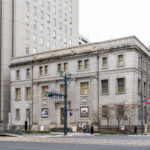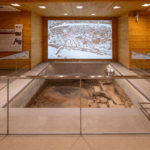I From Castle Town to a Modern City
1 Hiroshima, the Castle Town
During the Warring States period, the head of the Mori clan set up his base at Yoshida Koriyamajo Castle and became the greatest daimyo of western Japan, ruling over most of the Chugoku region. After choosing the Hiroshima bay area as the capital of his domain, Terumoto Mori built Hiroshima Castle. He modeled his castle after Jurakudai in Kyoto and Osaka Castle, which were built by Toyotomi Hideyoshi. Mori was defeated at the battle of Sekigahara and forced into the two provinces of Suo and Nagato. After that, the head of the Fukushima clan became the lord of Hiroshima Castle and ruled over Aki and Bingo Provinces, today’s Hiroshima Prefecture. Fukushima was subsequently demoted and the head of the Asano clan entered Hiroshima. The southern part of the Bingo area was cut off, and the head of the Mizuno clan then entered the Fukuyama area. During the Edo period, Hiroshima developed as the castle town of the Asano family, who governed the provinces of Aki and Bingo, in which 430,000 koku of rice was harvested. At the time, Edo, Osaka and Kyoto were the biggest cities in Japan, but Hiroshima also became a big city, on the same scale as Kumamoto, although smaller than Nagoya and Kanazawa.
The town area of Hiroshima Castle consisted of the castle, the samurai residential area, the tradesmen and artisans’ district, the temple district, and the newly reclaimed Shinkai area. The samurai residences occupied a wide area surrounding the castle and other strategic locations. The tradesmen and artisans’ district developed around the periphery of this area and along the roads. It was comprised of five communities: Shin-machi, Nakadori, Shirakami, Nakajima, and Hirose. Toward the sea, continuous land reclamation was undertaken south of the tradesmen and artisans’ district. At the time Hiroshima Castle was constructed, the seashore was around the area of today’s Peace Boulevard. Land reclamation was carried out vigorously by the feudal government of the Hiroshima Domain and wealthy townspeople, and the islands of Niho and Eba were connected to the mainland.
The population of the machi-gumi (communities in the tradesmen and artisans’ district) grew with the development of the castle town but began to decline in the late 18th century. In contrast to this decline, the population of Shinkai, the newly reclaimed land continuously grew; and in the early 19th century, the population of Shinkai was nearly the same as that of the five communities in the tradesmen and artisans’ district. The combined population of Shinkai and the five communities was around 50,000 at that time. On the other hand, during the middle of the Edo period, the estimated population of the samurai class was around 19,000.
2 Changes in the Administration System
After the tumultuous closing days of the Tokugawa Shogunate, the newly established Meiji government aimed to become a centralized government body, replacing the old system. In July 1871, the abolishment of the feudal provinces and the establishment of prefectures were decisively implemented. Through this, Hiroshima Han (or domain), under the rule of the Asano family, was abolished and Hiroshima Prefecture was born. In 1876, the six regions of Bingo were merged with Hiroshima Prefecture, and the prefecture reached the same total area as that of today. Initially, the prefectural government office was set up in Honmaru (main compound) of the Hiroshima Castle, but as the First Outpost of the Chinzei (Kyushu) Garrison was established in Honmaru, the government office was relocated to Sannomaru (third compound) of the castle in October 1871. Then, as military barracks were built at Sannomaru, the prefectural office was subsequently relocated to a temporary office at the Kokutaiji Temple in Ko-machi. As an accidental fire broke out and burned the office to the ground in December of 1876, the temporary prefectural office was yet again moved to Butsugoji Temple in Tera-machi. In April 1878, a new building was constructed and the prefectural office was moved to Kako-machi. While the military facilities occupied the castle area in the northern part of the town, the prefectural office was located in the south, near the southernmost of the delta of the Ota River. With the establishment of the prefectural office, the town of Hiroshima became the capital of the prefecture; and with the garrison, Hiroshima maintained its position as the regional center of politics and military.
The local administrative division underwent many changes as the prefecture was being established. In October 1871, the Hiroshima Prefectural Government drew up 158 wards within the prefecture to start a family registry system. At this time, the castle town of Hiroshima was divided into four wards. The following year, in order to set up administrative wards and organize the family registry system, a “daiku-shoku system” (large and small ward system) was adopted. The castle town of Hiroshima, as well as regional gun (counties) became large wards, and these large wards were then divided into small wards. The castle town of Hiroshima became the “First Large Ward,” which was made up of 12 (initially 24) small wards.
In November 1878, a “county, ward, town, and village” system was implemented, marking the revival of the old system of counties, towns and villages in Hiroshima Prefecture. Wards were only set up in urban areas. As a result, Hiroshima Prefecture came to consist of Hiroshima Ward and 22 counties, and public offices were established in all towns and villages. The Hiroshima Ward Office was set up at Otesuji 1-Chome, and was later moved first to Shinkawaba-cho and then to Nakajima Shin-machi.
In April 1889, a “city, town and village” system was implemented and the City of Hiroshima became one of the nation’s 32 cities. Outside the City of Hiroshima, old towns and villages merged, and new towns and villages were established. The ward office, formerly a rice granary of the previous Hiroshima Domain in Nakajima Shin-machi, was converted into the city hall. This building was used for a long time, and in 1928, new city hall was finally constructed in Kokutaiji-machi. The City of Hiroshima then expanded as the urbanization of the area progressed. In 1904, Moto-Ujina, which belonged to Nihojima Village in Aki County, was added to the city, and in 1929, the city merged seven surrounding towns and villages: Niho Village, Yaga Village and Ushita Village in Aki County; Misasa Town in Asa County; and Koi Town, Furuta Village and Kusatsu Town in Saeki County.
3 The Construction of Ujina Port
Hiroshima developed on the delta of a river, which made it easy for small boats to enter the central part of the city. However, the issue of constructing a port to allow larger vessels to access the city had been up in the air since the closing days of the Tokugawa Shogunate. This idea finally came to fruition with the construction of Ujina Port, which was originally carried out along with other job-creating policies intended to provide work for former samurai. In the first half of the Meiji period, poverty among the former samurai class became a problem, and sheltered work programs for former samurai sprung up throughout Japan. It was under these circumstances that the reclamation of Ujina Bay and the construction of the port were planned. After Sadaaki Senda took office as Governor of Hiroshima Prefecture in 1880, he quickly became engaged in this project.
Even before this time, there had been a history of land reclamation dating back to the Edo period, and in 1868, needy people were employed to newly reclaim and develop land at Kogo. However, the scale of this new construction project was too massive. Construction costs soared, and there was strong opposition from the fishermen in the Oko district, who were to lose their fishing grounds. But through the strong leadership of Governor Senda, construction began anew in September of 1884 and the arduous undertaking was completed in November 1889. A total of 620,000 tsubo (approximately 2,046,000 square meters) of land was created through this project, enabling large ships to enter the port.
Of this newly created land, 510,000 tsubo (approximately 1,686,000 square meters) was handed over to the vocational center for former samurai in Hiroshima, but as the land was not suitable for cultivation due to its high salinity, the sheltered work programs did not succeed. The usefulness of Ujina Port was not recognized, either. There was criticism against the construction of the port, saying the construction was not necessary or urgent. However, with the outbreak of the First Sino-Japanese War, the port became a military transport hub five years after it was completed, and rather than being used for commercial purposes as was first intended, it developed into a military post.
4 Development of Transportation Networks and Changes in the Layout of the City
Located on a delta, and intersected by seven rivers, Hiroshima enjoyed easy water transport, but was lacking in terms of land transport. Other than the bridges on the Saigoku Kaido Road, there were only two bridges: Yokogawa Bridge on the Izumo Kaido Road, and Ushita Bridge (also called Kanda Bridge) upstream of the Kyobashi River during the Edo period; and ferries were used where there were no bridges. After the Meiji Restoration, the ban on bridge building was lifted, and many bridges were built. For example, on the Motoyasu River alone, there were five bridges from upstream: Higashi-Aioi Bridge (1878), Motoyasu Bridge (during the Mori period in the 16th century), Shimbashi Bridge (present-day Heiwa-Ohashi Bridge, 1874), Yorozuyo Bridge (1878), and Meiji Bridge (1886). Four of these bridges were newly built in the early Meiji period. However, crossing fees were collected at each bridge, and ferry crossings remained at many places in the city. By the early Showa period, ferries disappeared almost entirely through modernization of the road system.
The Sanyo Railroad, which was eventually to connect Kobe and Shimonoseki, opened to Itozaki in July of 1892; and in June of 1894, it reached Hiroshima (it was later extended to Tokuyama in 1897 and to the terminal of Shimonoseki in 1901). The railways avoided the center of the city and ran along the outer edge of the delta, but with Hiroshima Station in the east, Yokogawa Station in the north, and Koi Station in the west, the urban area of the city expanded. After that, a railway from Yokogawa to Kabe (later named the National Railway Kabe Line) and a railway connecting Hiroshima to Shobara (later the National Railway Geibi Line) opened, strengthening the links between the suburban villages, the northern part of the prefecture, and the city of Hiroshima. Also, in 1912, the streetcar network opened and gradually extended its lines to connect Hiroshima Station, Hatchobori, Kamiya-cho, Koi Station, Yokogawa Station, Ujina, and other important locations by streetcar.
Hiroshima continued to develop along the Saigoku Kaido Road, in the area from Kyobashi to Sakai-machi, during the Edo period. In the early Meiji period (in the 19th century) development expanded in Sakai-machi and Nakajima, along the Honkawa and the Motoyasu Rivers, due to their easy access by water transport. During the Taisho period in the early 20th century, Hatchobori, in the east, became the busiest downtown area as the streetcars opened. The Shintenchi and Higashi-Shintenchi areas were newly developed, and Hondori Street, connecting Nakajima to the eastern part of the city, also prospered. In 1929, the first department store in Hiroshima opened in the northern part of Hatchobori. The opening of the streetcar network stimulated the development of Takanobashi, the area in front of Hiroshima Station, and the coastal area of Ujina.
A view overlooking the Aioi Bridge, the Nakajima district, and the Industrial Promotion Hall as seen from the Hiroshima Prefectural Commerce, Industry and Economic Association building (today’s Hiroshima Chamber of Commerce and Industry) at the east end of the Aioi Bridge around 1938. (Photo by Wakaji Matsumoto)
Notes






